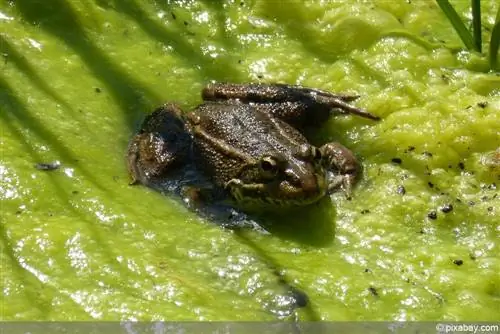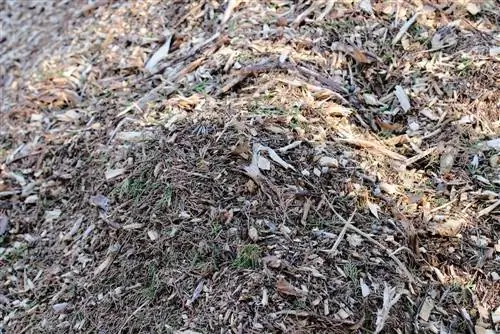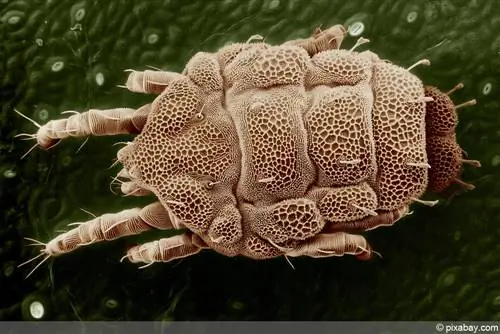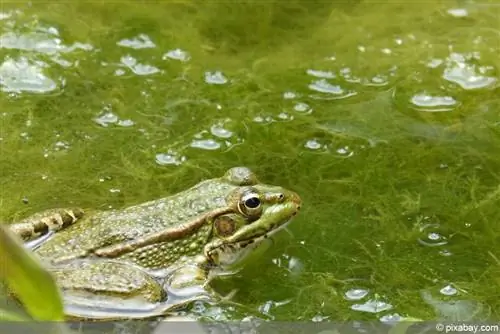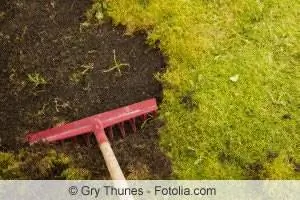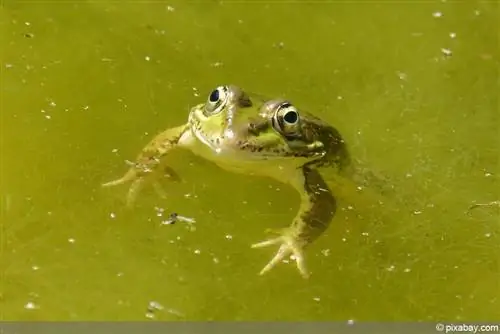- Author admin [email protected].
- Public 2023-12-17 03:39.
- Last modified 2025-01-24 12:45.
Algae infestation in the garden pond is an annoying nuisance. Before you know it, the pond water turns green. But it's not just the pond owners who are bothered by the “green broth”, plants and animals also suffer from the algae bloom. In order to make life worth living for the pond inhabitants again, the algae must be removed. Products containing copper sulfate help against the plague, but should be used with caution,
CUSo4
Copper sulfate (CuSO4) is an algaecide, i.e. an agent that kills algae. It is used preventively or to treat algae infestation. This is why it is used, for example, in ponds, lakes or biotopes to combat algae blooms. However, caution is advised when using it, because CuSO4 not only helps against algae plagues, but can also destroy invertebrates such as snails. Since it can reduce the oxygen concentration in the water, it can also lead to the death of pond fish.
Copper sulfate products may contain copper sulfate pentahydrate, a blue crystalline powder, or anhydrous CuSo4, a white crystalline powder. Pure CuSO4 is available in pharmacies or drugstores.
Products
Copper sulfate products are used not only in garden ponds, but also in pools. Therefore, before purchasing, you should find out exactly whether the product you choose is suitable for ponds with fish or for the aquarium. The relevant information can be found in the manufacturer's product information. However, there is no guarantee that, even when used correctly, products that are described as being gentle on fish and plants will not cause any harm to wildlife, according to the manufacturer.
Application
Remedies against algae infestation should be used as early as possible. If the infestation is already in an advanced stage, there is a distinct possibility that CuSO4 products will no longer help, unless you want to kill all life in the pond. This is usually the case when the infestation is over 30 percent. Because to kill the algae bloom, such a high concentration is needed that living beings no longer survive the treatment. Therefore, you should combat the plague preventively. You can also prevent the plague from being introduced, for example by purchasing ornamental fish or aquatic plants.
Summer protection
To protect the pond in the garden from algae infestation in summer, there are special products that are aimed at algae blooms in summer.
Dosage
When dosing CuSO4 against algae, you should definitely follow the manufacturer's instructions so that plants and animals in the garden pond are not harmed. A distinction is usually made between a cure and a new settlement for ponds in the garden.
Applying
So that the products can spread their effect optimally, they must be distributed evenly in the pond water. That's why many manufacturers recommend:
- Dilute product according to proportion
- Distribute diluted solution in the garden pond with a watering can
- for undiluted products: avoid contact with aquatic plants
Copper content in water
In order to counteract the new colonization of algae species in the aquarium, some manufacturers recommend using the product permanently. However, you should not ignore the copper content in the water so as not to harm plants and fish. You should expect the following damage from long-term exposure to water:
- Bacteria: 0.03 milligrams per liter
- Higher aquatic plants: 0.08 milligrams per liter
- Fish: 0.10 milligrams per liter
Note:
With long-term exposure to 0.2 milligrams per liter of copper, you can expect fish deaths.
The combination of soft water and copper is particularly dangerous for plants and fish. A copper content of 0.03 milligrams per liter is enough to cause damage. In the garden pond, copper settles in the sediment at the bottom of the pond. Damage to fish can be expected from a concentration of 0.1 milligrams per liter. The combination of low pH and soft water also poses a particular danger to fish in ponds. The critical limit is 0.03 milligrams per liter.
Prohibitions
In Austria, CuSO4 has been banned for swimming pool water treatment since 2017. This ban does not exist in Germany. However, pool water that has been treated with a copper sulfate solution must be disposed of according to specific regulations.
Note:
CuSO4 is toxic to all living things. Since it is also considered a pollutant for water, it has been classified in hazard class 2 according to the classification of substances that pose a risk to water.

